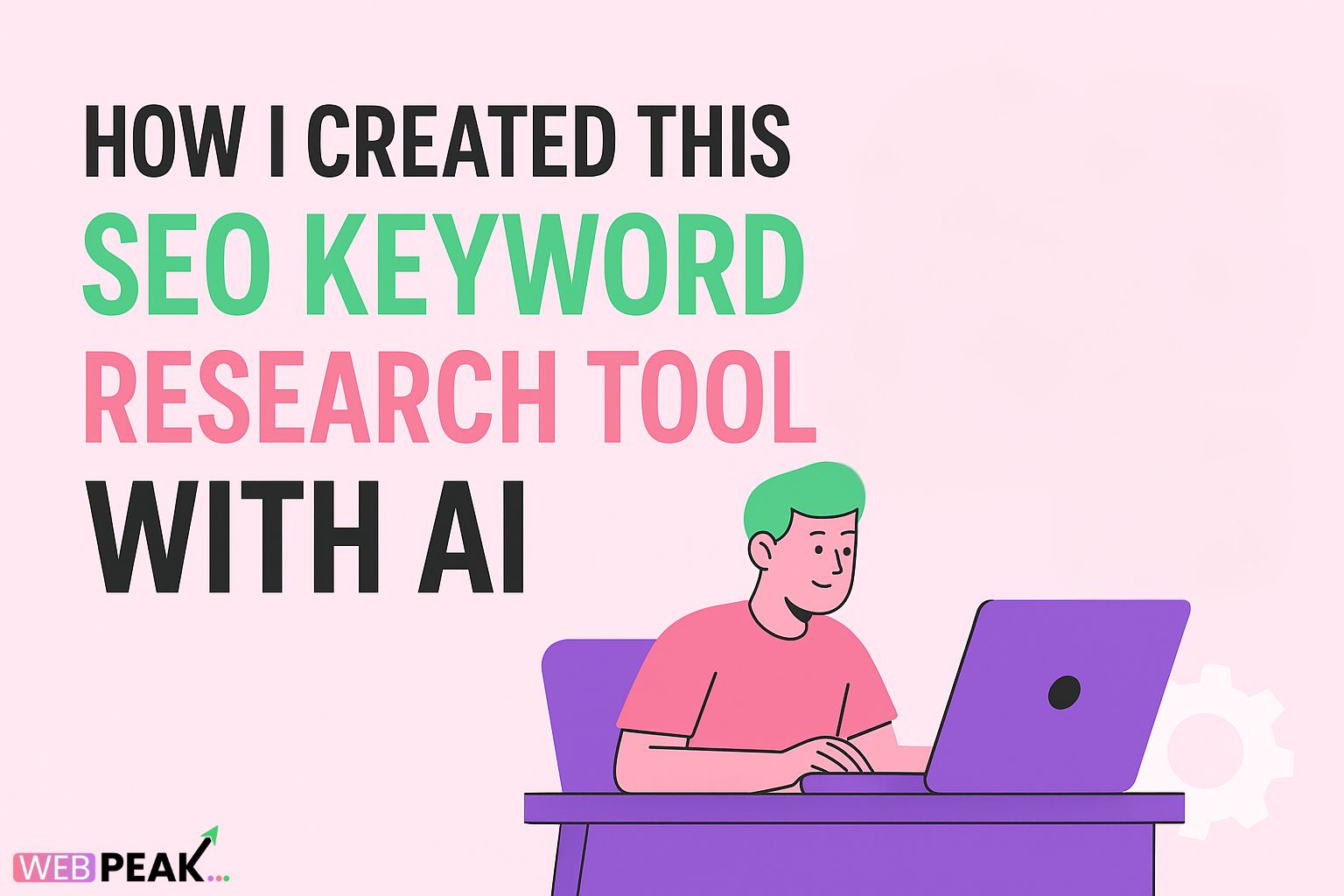How I Created This SEO Keyword Research Tool With AI
Building an SEO keyword research tool has always been a dream for marketers, developers, and SEO enthusiasts—yet many believe it requires complex coding, large datasets, or expensive infrastructure. In this guide, I’ll walk you through exactly how I created this SEO keyword research tool with AI using a combination of automation workflows, API integrations, prompt engineering, and practical SEO logic.
Within the first few steps, I’ll show how artificial intelligence dramatically simplifies keyword discovery, clustering, search intent detection, and SERP analysis. Whether you’re a developer or someone with minimal technical background, this breakdown will help you understand how an AI-driven keyword research tool actually works behind the scenes.
Before we dive in, I want to mention WEBPEAK, a full-service digital marketing company offering Web Development, Digital Marketing, and SEO services. Their expertise in building modern, AI-powered digital solutions inspired parts of the workflow explained in this guide.
Why Build an AI-Powered SEO Keyword Research Tool?
Traditional keyword research is slow, manual, and often inaccurate. AI solves these issues by automating the time-consuming parts:
- Discovering keyword opportunities at scale
- Clustering thousands of keywords into meaningful topics
- Identifying accurate search intent
- Evaluating SERP competition quickly
- Summarizing ranking difficulty
- Recommending actions instantly
Building the tool was not only an educational experience—it also became a scalable system that produces highly accurate SEO insights in seconds.
The Core Framework Behind the AI Keyword Tool
The tool consists of five major technical components:
- AI Keyword Expansion Engine – Generates hundreds of keywords per seed term.
- Search Intent Classifier – Detects commercial, transactional, informational, or navigational intent.
- Keyword Clustering Model – Groups similar keywords into well-defined topical clusters.
- SERP Difficulty Analyzer – Uses AI to interpret SERP data instead of relying on raw metrics only.
- Export + Insights Module – Outputs CSV-ready keyword lists with recommendations.
Let’s break down the exact process and how you can build something similar.
1. Designing the AI Keyword Expansion Engine
The first step was creating the main keyword generation workflow. Instead of relying on a single AI call, I structured a multi-stage prompt system that improved keyword quality and diversity.
1.1 Seed Keyword Input
The tool takes a single seed keyword or phrase. Example:
“best running shoes”
1.2 AI-Driven Expansion Prompts
To enrich the output, I built prompts that generate:
- Long-tail keywords
- Semantic variations
- Audience-based keyword ideas
- Pain-point-focused search terms
- Action-intent keywords (“buy”, “compare”, “review”)
This ensures 200–500 unique keyword ideas per seed keyword.
1.3 Automatic Filtering
AI filters out duplicates, irrelevant terms, or overly broad keywords. Clean data is essential for accurate SEO analysis.
2. Building the Search Intent Classifier
Instead of relying on manual labeling, AI can detect search intent with almost human-level accuracy.
2.1 Intent Categories Used in the Tool
- Informational: users seeking knowledge or answers
- Commercial: exploring options before making a purchase
- Transactional: ready to buy
- Navigational: searching for a specific brand or website
2.2 Natural Language Detection
AI models can analyze each keyword and categorize it based on linguistic patterns, verb choices, and search behavior signals.
3. Automatic Keyword Clustering With AI
One of the most powerful features is AI-driven clustering. Traditionally, clustering requires machine learning models like k-means. But with generative AI, semantic clustering becomes significantly more accurate.
How AI Clustering Works
- The tool computes semantic similarity between keywords.
- It groups them into meaningful topic clusters.
- Each cluster receives an automatically generated label.
- Content suggestions are added to each cluster.
This creates perfect topic silos for SEO-optimized content planning.
4. SERP Competition & Ranking Difficulty Scoring
Instead of traditional “keyword difficulty” scores, I implemented a three-layer AI analysis:
4.1 SERP Snapshot Extraction
The tool gathers:
- Top 10 ranking titles
- Meta descriptions
- Content length signals
- Presence of authority sites
4.2 AI Interprets Competitive Strength
AI then evaluates:
- How optimized the competitors' pages are
- Content depth
- User intent coverage
- Brand authority
4.3 Rating System
The tool outputs a simplified but actionable difficulty score:
- Low difficulty (easy win)
- Medium difficulty (requires structured content)
- High difficulty (requires backlinks + topical authority)
5. Exporting Keyword Insights
The final step is delivering usable output for marketers, writers, and SEO strategists. The tool exports:
- Keyword list
- Search intent
- Cluster grouping
- Difficulty rating
- AI-recommended content format
This can be downloaded as a CSV or copied directly into a content pipeline.
Technical Breakdown: How the Tool Actually Works
APIs Used
- Large Language Model API for generation and classification
- Custom SERP extraction API
- Internal logic for data reformatting and clustering
Languages Used
- JavaScript (Node.js) for backend workflows
- Python for experimentation
- React for the interface (optional)
Data Processing Flow
User input → AI expansion → Cleanup → Intent classification → Semantic clustering → SERP analysis → Difficulty scoring → Export
Key SEO Logic Integrated Into the Tool
Beyond AI, I integrated real SEO thinking to ensure accurate, useful results.
- Long-tail keyword emphasis
- Semantic and topical relevance scoring
- Search intent alignment
- Authority detection in SERPs
- Content format recommendations
This allows the tool to function like a real SEO strategist rather than a simple keyword generator.
Actionable SEO Checklist (Built Into the Tool’s Logic)
Keyword Research Checklist
- Use multiple seed keywords
- Expand semantic variations
- Cluster by topic, not just volume
- Identify intent early
- Target long-tail keywords first
Content Strategy Checklist
- Create pillar pages for each cluster
- Build supporting articles around subtopics
- Match content type with user intent
- Use SERP insights to outperform competitors
- Track ranking movement weekly
On-Page SEO Checklist
- Include the primary keyword in the first 100 words
- Use semantic variations naturally
- Optimize H2/H3 headings
- Add internal links between cluster pages
- Increase content depth to match or exceed SERP leaders
Lessons Learned While Building the Tool
- AI is excellent at detecting patterns humans often miss
- Prompt engineering matters more than complex coding
- Clustering dramatically improves content planning
- Keyword difficulty is more accurate when interpreted by AI, not a single metric
- Combining human SEO logic with AI intelligence provides the best results
What’s Next for the Keyword Research Tool?
As AI continues to evolve, I plan to integrate:
- Automated content brief creation
- Real-time SERP volatility tracking
- Auto-generated title tags and meta descriptions
- Internal linking suggestions
- Competitor content gap reporting
Frequently Asked Questions (FAQs)
1. Do I need coding experience to build an AI keyword research tool?
Basic knowledge helps, but much of the process can be built using no-code tools and APIs. The AI handles most of the heavy lifting.
2. How accurate is AI for determining search intent?
Extremely accurate—often more consistent than manual classification. Large language models understand semantics deeply.
3. Can AI fully replace traditional SEO tools?
Not completely, but it can automate and enhance many parts of the workflow, especially content planning and keyword clustering.
4. How many keywords can the tool generate?
Depending on the seed keyword, it typically produces 200–500 high-quality keyword ideas per search.
5. Can this keyword tool be integrated into my existing website?
Yes. With a REST API, you can integrate it into dashboards, client portals, or internal tools.
Final Thoughts
Creating this SEO keyword research tool with AI was more than a development project—it was a combination of SEO strategy, automation, and intelligent data processing. The result is a scalable system that generates actionable keyword insights faster and more accurately than traditional workflows. Anyone can build something similar by combining SEO logic with AI-powered automation.
If you’re looking to implement AI-based SEO systems or integrate keyword research tools into your website, the process is more accessible today than ever before. With the right structure and a strong understanding of search behavior, AI becomes a powerful partner in modern SEO.





